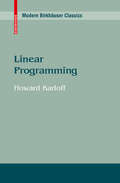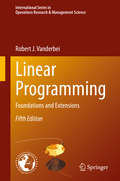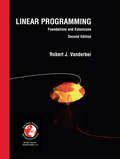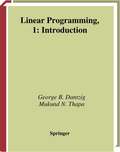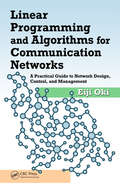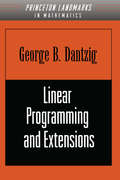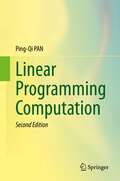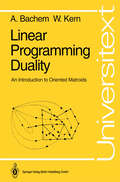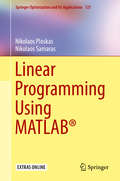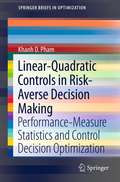- Table View
- List View
Linear Programming (Modern Birkhäuser Classics)
by Howard KarloffTo this reviewer’s knowledge, this is the first book accessible to the upper division undergraduate or beginning graduate student that surveys linear programming…. Style is informal. ...Recommended highly for acquisition, since it is not only a textbook, but can also be used for independent reading and study. —Choice Reviews This is a textbook intended for advanced undergraduate or graduate students. It contains both theory and computational practice. —Zentralblatt Math
Linear Programming: A Modern Integrated Analysis (International Series in Operations Research & Management Science #1)
by Romesh SaigalIn Linear Programming: A Modern Integrated Analysis, both boundary (simplex) and interior point methods are derived from the complementary slackness theorem and, unlike most books, the duality theorem is derived from Farkas's Lemma, which is proved as a convex separation theorem. The tedium of the simplex method is thus avoided. A new and inductive proof of Kantorovich's Theorem is offered, related to the convergence of Newton's method. Of the boundary methods, the book presents the (revised) primal and the dual simplex methods. An extensive discussion is given of the primal, dual and primal-dual affine scaling methods. In addition, the proof of the convergence under degeneracy, a bounded variable variant, and a super-linearly convergent variant of the primal affine scaling method are covered in one chapter. Polynomial barrier or path-following homotopy methods, and the projective transformation method are also covered in the interior point chapter. Besides the popular sparse Cholesky factorization and the conjugate gradient method, new methods are presented in a separate chapter on implementation. These methods use LQ factorization and iterative techniques.
Linear Programming: Foundations and Extensions (International Series in Operations Research & Management Science #196)
by Robert J VanderbeiThis Fourth Edition introduces the latest theory and applications in optimization. It emphasizes constrained optimization, beginning with a substantial treatment of linear programming and then proceeding to convex analysis, network flows, integer programming, quadratic programming, and convex optimization. Readers will discover a host of practical business applications as well as non-business applications.Topics are clearly developed with many numerical examples worked out in detail. Specific examples and concrete algorithms precede more abstract topics. With its focus on solving practical problems, the book features free C programs to implement the major algorithms covered, including the two-phase simplex method, primal-dual simplex method, path-following interior-point method, and homogeneous self-dual methods. In addition, the author provides online JAVA applets that illustrate various pivot rules and variants of the simplex method, both for linear programming and for network flows. These C programs and JAVA tools can be found on the book's website. The website also includes new online instructional tools and exercises.
Linear Programming: Foundations and Extensions (International Series in Operations Research & Management Science #285)
by Robert J. VanderbeiThe book provides a broad introduction to both the theory and the application of optimization with a special emphasis on the elegance, importance, and usefulness of the parametric self-dual simplex method. The book assumes that a problem in “standard form,” is a problem with inequality constraints and nonnegative variables. The main new innovation to the book is the use of clickable links to the (newly updated) online app to help students do the trivial but tedious arithmetic when solving optimization problems.The latest edition now includes: a discussion of modern Machine Learning applications, as motivational material; a section explaining Gomory Cuts and an application of integer programming to solve Sudoku problems. Readers will discover a host of practical business applications as well as non-business applications. Topics are clearly developed with many numerical examples worked out in detail. Specific examples and concrete algorithms precede more abstract topics. With its focus on solving practical problems, the book features free C programs to implement the major algorithms covered, including the two-phase simplex method, the primal-dual simplex method, the path-following interior-point method, and and the homogeneous self-dual method. In addition, the author provides online tools that illustrate various pivot rules and variants of the simplex method, both for linear programming and for network flows. These C programs and online pivot tools can be found on the book's website. The website also includes new online instructional tools and exercises.
Linear Programming: Foundations and Extensions (International Series in Operations Research & Management Science #37)
by Robert J VanderbeiThis book provides an introduction to optimization. It details constrained optimization, beginning with a substantial treatment of linear programming and proceeding to convex analysis, network flows, integer programming, quadratic programming, and convex optimization. Coverage underscores the purpose of optimization: to solve practical problems on a computer. C programs that implement the major algorithms and JAVA tools are available online.
Linear Programming: Foundations and Extensions (International Series in Operations Research & Management Science #114)
by Robert J VanderbeiThis Third Edition introduces the latest theory and applications in optimization. It emphasizes constrained optimization, beginning with linear programming and then proceeding to convex analysis, network flows, integer programming, quadratic programming, and convex optimization. You’ll discover a host of practical business applications as well as non-business applications. With its focus on solving practical problems, the book features free C programs to implement the major algorithms covered. The book’s accompanying website includes the C programs, JAVA tools, and new online instructional tools and exercises.
Linear Programming 1: Introduction (Springer Series in Operations Research and Financial Engineering)
by George B. Dantzig Mukund N. ThapaEncompassing all the major topics students will encounter in courses on the subject, the authors teach both the underlying mathematical foundations and how these ideas are implemented in practice. They illustrate all the concepts with both worked examples and plenty of exercises, and, in addition, provide software so that students can try out numerical methods and so hone their skills in interpreting the results. As a result, this will make an ideal textbook for all those coming to the subject for the first time. Authors' note: A problem recently found with the software is due to a bug in Formula One, the third party commercial software package that was used for the development of the interface. It occurs when the date, currency, etc. format is set to a non-United States version. Please try setting your computer date/currency option to the United States option . The new version of Formula One, when ready, will be posted on WWW.
Linear Programming 2: Theory and Extensions (Springer Series in Operations Research and Financial Engineering)
by George B. Dantzig Mukund N. ThapaGeorge Dantzig is widely regarded as the founder of this subject with his invention of the simplex algorithm in the 1940's. In this second volume, the theory of the items discussed in the first volume is expanded to include such additional advanced topics as variants of the simplex method; interior point methods, GUB, decomposition, integer programming, and game theory. Graduate students in the fields of operations research, industrial engineering and applied mathematics will thus find this volume of particular interest.
Linear Programming and Algorithms for Communication Networks: A Practical Guide to Network Design, Control, and Management
by Eiji OkiExplaining how to apply to mathematical programming to network design and control, Linear Programming and Algorithms for Communication Networks: A Practical Guide to Network Design, Control, and Management fills the gap between mathematical programming theory and its implementation in communication networks. From the basics all the way through to m
Linear Programming and Algorithms for Communication Networks: A Practical Guide to Network Design, Control, and Management
by Eiji OkiExplaining how to apply to mathematical programming to network design and control, Linear Programming and Algorithms for Communication Networks: A Practical Guide to Network Design, Control, and Management fills the gap between mathematical programming theory and its implementation in communication networks. From the basics all the way through to m
Linear Programming and Extensions
by George DantzigIn real-world problems related to finance, business, and management, mathematicians and economists frequently encounter optimization problems. In this classic book, George Dantzig looks at a wealth of examples and develops linear programming methods for their solutions. He begins by introducing the basic theory of linear inequalities and describes the powerful simplex method used to solve them. Treatments of the price concept, the transportation problem, and matrix methods are also given, and key mathematical concepts such as the properties of convex sets and linear vector spaces are covered. George Dantzig is properly acclaimed as the "father of linear programming." Linear programming is a mathematical technique used to optimize a situation. It can be used to minimize traffic congestion or to maximize the scheduling of airline flights. He formulated its basic theoretical model and discovered its underlying computational algorithm, the "simplex method," in a pathbreaking memorandum published by the United States Air Force in early 1948. Linear Programming and Extensions provides an extraordinary account of the subsequent development of his subject, including research in mathematical theory, computation, economic analysis, and applications to industrial problems. Dantzig first achieved success as a statistics graduate student at the University of California, Berkeley. One day he arrived for a class after it had begun, and assumed the two problems on the board were assigned for homework. When he handed in the solutions, he apologized to his professor, Jerzy Neyman, for their being late but explained that he had found the problems harder than usual. About six weeks later, Neyman excitedly told Dantzig, "I've just written an introduction to one of your papers. Read it so I can send it out right away for publication." Dantzig had no idea what he was talking about. He later learned that the "homework" problems had in fact been two famous unsolved problems in statistics.
Linear Programming and Generalizations: A Problem-based Introduction with Spreadsheets (International Series in Operations Research & Management Science #149)
by Eric V. DenardoThis book on constrained optimization is novel in that it fuses these themes: • use examples to introduce general ideas; • engage the student in spreadsheet computation; • survey the uses of constrained optimization;. • investigate game theory and nonlinear optimization, • link the subject to economic reasoning, and • present the requisite mathematics. Blending these themes makes constrained optimization more accessible and more valuable. It stimulates the student’s interest, quickens the learning process, reveals connections to several academic and professional fields, and deepens the student’s grasp of the relevant mathematics. The book is designed for use in courses that focus on the applications of constrained optimization, in courses that emphasize the theory, and in courses that link the subject to economics.
Linear Programming and Network Flows
by Mokhtar S. Bazaraa John J. Jarvis Hanif D. SheraliThe authoritative guide to modeling and solving complex problems with linear programming—extensively revised, expanded, and updated The only book to treat both linear programming techniques and network flows under one cover, Linear Programming and Network Flows, Fourth Edition has been completely updated with the latest developments on the topic. This new edition continues to successfully emphasize modeling concepts, the design and analysis of algorithms, and implementation strategies for problems in a variety of fields, including industrial engineering, management science, operations research, computer science, and mathematics. The book begins with basic results on linear algebra and convex analysis, and a geometrically motivated study of the structure of polyhedral sets is provided. Subsequent chapters include coverage of cycling in the simplex method, interior point methods, and sensitivity and parametric analysis. Newly added topics in the Fourth Edition include: The cycling phenomenon in linear programming and the geometry of cycling Duality relationships with cycling Elaboration on stable factorizations and implementation strategies Stabilized column generation and acceleration of Benders and Dantzig-Wolfe decomposition methods Line search and dual ascent ideas for the out-of-kilter algorithm Heap implementation comments, negative cost circuit insights, and additional convergence analyses for shortest path problems The authors present concepts and techniques that are illustrated by numerical examples along with insights complete with detailed mathematical analysis and justification. An emphasis is placed on providing geometric viewpoints and economic interpretations as well as strengthening the understanding of the fundamental ideas. Each chapter is accompanied by Notes and References sections that provide historical developments in addition to current and future trends. Updated exercises allow readers to test their comprehension of the presented material, and extensive references provide resources for further study. Linear Programming and Network Flows, Fourth Edition is an excellent book for linear programming and network flow courses at the upper-undergraduate and graduate levels. It is also a valuable resource for applied scientists who would like to refresh their understanding of linear programming and network flow techniques.
Linear Programming and Network Flows
by Mokhtar S. Bazaraa John J. Jarvis Hanif D. SheraliThe authoritative guide to modeling and solving complex problems with linear programming—extensively revised, expanded, and updated The only book to treat both linear programming techniques and network flows under one cover, Linear Programming and Network Flows, Fourth Edition has been completely updated with the latest developments on the topic. This new edition continues to successfully emphasize modeling concepts, the design and analysis of algorithms, and implementation strategies for problems in a variety of fields, including industrial engineering, management science, operations research, computer science, and mathematics. The book begins with basic results on linear algebra and convex analysis, and a geometrically motivated study of the structure of polyhedral sets is provided. Subsequent chapters include coverage of cycling in the simplex method, interior point methods, and sensitivity and parametric analysis. Newly added topics in the Fourth Edition include: The cycling phenomenon in linear programming and the geometry of cycling Duality relationships with cycling Elaboration on stable factorizations and implementation strategies Stabilized column generation and acceleration of Benders and Dantzig-Wolfe decomposition methods Line search and dual ascent ideas for the out-of-kilter algorithm Heap implementation comments, negative cost circuit insights, and additional convergence analyses for shortest path problems The authors present concepts and techniques that are illustrated by numerical examples along with insights complete with detailed mathematical analysis and justification. An emphasis is placed on providing geometric viewpoints and economic interpretations as well as strengthening the understanding of the fundamental ideas. Each chapter is accompanied by Notes and References sections that provide historical developments in addition to current and future trends. Updated exercises allow readers to test their comprehension of the presented material, and extensive references provide resources for further study. Linear Programming and Network Flows, Fourth Edition is an excellent book for linear programming and network flow courses at the upper-undergraduate and graduate levels. It is also a valuable resource for applied scientists who would like to refresh their understanding of linear programming and network flow techniques.
Linear Programming and Resource Allocation Modeling
by Michael J. PanikGuides in the application of linear programming to firm decision making, with the goal of giving decision-makers a better understanding of methods at their disposal Useful as a main resource or as a supplement in an economics or management science course, this comprehensive book addresses the deficiencies of other texts when it comes to covering linear programming theory—especially where data envelopment analysis (DEA) is concerned—and provides the foundation for the development of DEA. Linear Programming and Resource Allocation Modeling begins by introducing primal and dual problems via an optimum product mix problem, and reviews the rudiments of vector and matrix operations. It then goes on to cover: the canonical and standard forms of a linear programming problem; the computational aspects of linear programming; variations of the standard simplex theme; duality theory; single- and multiple- process production functions; sensitivity analysis of the optimal solution; structural changes; and parametric programming. The primal and dual problems are then reformulated and re-examined in the context of Lagrangian saddle points, and a host of duality and complementary slackness theorems are offered. The book also covers primal and dual quadratic programs, the complementary pivot method, primal and dual linear fractional functional programs, and (matrix) game theory solutions via linear programming, and data envelopment analysis (DEA). This book: Appeals to those wishing to solve linear optimization problems in areas such as economics, business administration and management, agriculture and energy, strategic planning, public decision making, and health care Fills the need for a linear programming applications component in a management science or economics course Provides a complete treatment of linear programming as applied to activity selection and usage Contains many detailed example problems as well as textual and graphical explanations Linear Programming and Resource Allocation Modeling is an excellent resource for professionals looking to solve linear optimization problems, and advanced undergraduate to beginning graduate level management science or economics students.
Linear Programming and Resource Allocation Modeling
by Michael J. PanikGuides in the application of linear programming to firm decision making, with the goal of giving decision-makers a better understanding of methods at their disposal Useful as a main resource or as a supplement in an economics or management science course, this comprehensive book addresses the deficiencies of other texts when it comes to covering linear programming theory—especially where data envelopment analysis (DEA) is concerned—and provides the foundation for the development of DEA. Linear Programming and Resource Allocation Modeling begins by introducing primal and dual problems via an optimum product mix problem, and reviews the rudiments of vector and matrix operations. It then goes on to cover: the canonical and standard forms of a linear programming problem; the computational aspects of linear programming; variations of the standard simplex theme; duality theory; single- and multiple- process production functions; sensitivity analysis of the optimal solution; structural changes; and parametric programming. The primal and dual problems are then reformulated and re-examined in the context of Lagrangian saddle points, and a host of duality and complementary slackness theorems are offered. The book also covers primal and dual quadratic programs, the complementary pivot method, primal and dual linear fractional functional programs, and (matrix) game theory solutions via linear programming, and data envelopment analysis (DEA). This book: Appeals to those wishing to solve linear optimization problems in areas such as economics, business administration and management, agriculture and energy, strategic planning, public decision making, and health care Fills the need for a linear programming applications component in a management science or economics course Provides a complete treatment of linear programming as applied to activity selection and usage Contains many detailed example problems as well as textual and graphical explanations Linear Programming and Resource Allocation Modeling is an excellent resource for professionals looking to solve linear optimization problems, and advanced undergraduate to beginning graduate level management science or economics students.
Linear Programming Computation
by Ping-Qi PANWith emphasis on computation, this book is a real breakthrough in the field of LP. In addition to conventional topics, such as the simplex method, duality, and interior-point methods, all deduced in a fresh and clear manner, it introduces the state of the art by highlighting brand-new and advanced results, including efficient pivot rules, Phase-I approaches, reduced simplex methods, deficient-basis methods, face methods, and pivotal interior-point methods. In particular, it covers the determination of the optimal solution set, feasible-point simplex method, decomposition principle for solving large-scale problems, controlled-branch method based on generalized reduced simplex framework for solving integer LP problems.
Linear Programming Computation
by Ping-Qi PANThis monograph represents a historic breakthrough in the field of linear programming (LP)since George Dantzig first discovered the simplex method in 1947. Being both thoughtful and informative, it focuses on reflecting and promoting the state of the art by highlighting new achievements in LP. This new edition is organized in two volumes. The first volume addresses foundations of LP, including the geometry of feasible region, the simplex method and its implementation, duality and the dual simplex method, the primal-dual simplex method, sensitivity analysis and parametric LP, the generalized simplex method, the decomposition method, the interior-point method and integer LP method. The second volume mainly introduces contributions of the author himself, such as efficient primal/dual pivot rules, primal/dual Phase-I methods, reduced/D-reduced simplex methods, the generalized reduced simplex method, primal/dual deficient-basis methods, primal/dual face methods, a new decomposition principle, etc.Many important improvements were made in this edition. The first volume includes new results, such as the mixed two-phase simplex algorithm, dual elimination, fresh pricing scheme for reduced cost, bilevel LP models and intercepting of optimal solution set. In particular, the chapter Integer LP Method was rewritten with great gains of the objective cutting for new ILP solvers {\it controlled-cutting/branch} methods, as well as with an attractive implementation of the controlled-branch method. In the second volume, the `simplex feasible-point algorithm' was rewritten, and removed from the chapter Pivotal Interior-Point Method to form an independent chapter with the new title `Simplex Interior-Point Method', as it represents a class of efficient interior-point algorithms transformed from traditional simplex algorithms. The title of the original chapter was then changed to `Facial Interior-Point Method', as the remaining algorithms represent another class of efficient interior-point algorithms transformed from normal interior-point algorithms. Without exploiting sparsity, the original primal/dual face methods were implemented using Cholesky factorization. In order to deal with sparse computation, two new chapters discussing LU factorization were added to the second volume. The most exciting improvement came from the rediscovery of the reduced simplex method. In the first edition, the derivation of its prototype was presented in a chapter with the same title, and then converted into the so-called `improved' version in another chapter. Fortunately, the author recently found a quite concise new derivation, so he can now introduce the distinctive fresh simplex method in a single chapter. It is exciting that the reduced simplex method can be expected to be the best LP solver ever.With a focus on computation, the current edition contains many novel ideas, theories and methods, supported by solid numerical results. Being clear and succinct, its content reveals in a fresh manner, from simple to profound. In particular, a larger number of examples were worked out to demonstrate algorithms. This book is a rare work in LP and an indispensable tool for undergraduate and graduate students, teachers, practitioners, and researchers in LP and related fields.
Linear Programming Duality: An Introduction to Oriented Matroids (Universitext)
by Achim Bachem Walter KernLinear Programming: Mathematics, Theory and Algorithms (Applied Optimization #2)
by M.J. PanikLinear Programming provides an in-depth look at simplex based as well as the more recent interior point techniques for solving linear programming problems. Starting with a review of the mathematical underpinnings of these approaches, the text provides details of the primal and dual simplex methods with the primal-dual, composite, and steepest edge simplex algorithms. This then is followed by a discussion of interior point techniques, including projective and affine potential reduction, primal and dual affine scaling, and path following algorithms. Also covered is the theory and solution of the linear complementarity problem using both the complementary pivot algorithm and interior point routines. A feature of the book is its early and extensive development and use of duality theory. Audience: The book is written for students in the areas of mathematics, economics, engineering and management science, and professionals who need a sound foundation in the important and dynamic discipline of linear programming.
Linear Programming Models and Methods of Matrix Games with Payoffs of Triangular Fuzzy Numbers (Studies in Fuzziness and Soft Computing #328)
by Deng-Feng LiThis book addresses two-person zero-sum finite games in which the payoffs in any situation are expressed with fuzzy numbers. The purpose of this book is to develop a suite of effective and efficient linear programming models and methods for solving matrix games with payoffs in fuzzy numbers. Divided into six chapters, it discusses the concepts of solutions of matrix games with payoffs of intervals, along with their linear programming models and methods. Furthermore, it is directly relevant to the research field of matrix games under uncertain economic management. The book offers a valuable resource for readers involved in theoretical research and practical applications from a range of different fields including game theory, operational research, management science, fuzzy mathematical programming, fuzzy mathematics, industrial engineering, business and social economics.
Linear Programming Using MATLAB® (Springer Optimization and Its Applications #127)
by Nikolaos Ploskas Nikolaos SamarasThis book offers a theoretical and computational presentation of a variety of linear programming algorithms and methods with an emphasis on the revised simplex method and its components. A theoretical background and mathematical formulation is included for each algorithm as well as comprehensive numerical examples and corresponding MATLAB® code. The MATLAB® implementations presented in this book are sophisticated and allow users to find solutions to large-scale benchmark linear programs. Each algorithm is followed by a computational study on benchmark problems that analyze the computational behavior of the presented algorithms. As a solid companion to existing algorithmic-specific literature, this book will be useful to researchers, scientists, mathematical programmers, and students with a basic knowledge of linear algebra and calculus. The clear presentation enables the reader to understand and utilize all components of simplex-type methods, such as presolve techniques, scaling techniques, pivoting rules, basis update methods, and sensitivity analysis.
Linear-Quadratic Controls in Risk-Averse Decision Making: Performance-Measure Statistics and Control Decision Optimization (SpringerBriefs in Optimization)
by Khanh D. PhamLinear-Quadratic Controls in Risk-Averse Decision Making cuts across control engineering (control feedback and decision optimization) and statistics (post-design performance analysis) with a common theme: reliability increase seen from the responsive angle of incorporating and engineering multi-level performance robustness beyond the long-run average performance into control feedback design and decision making and complex dynamic systems from the start. This monograph provides a complete description of statistical optimal control (also known as cost-cumulant control) theory. In control problems and topics, emphasis is primarily placed on major developments attained and explicit connections between mathematical statistics of performance appraisals and decision and control optimization. Chapter summaries shed light on the relevance of developed results, which makes this monograph suitable for graduate-level lectures in applied mathematics and electrical engineering with systems-theoretic concentration, elective study or a reference for interested readers, researchers, and graduate students who are interested in theoretical constructs and design principles for stochastic controlled systems.
Linear Regression (Lecture Notes in Statistics #175)
by Jürgen GroßThe book covers the basic theory of linear regression models and presents a comprehensive survey of different estimation techniques as alternatives and complements to least squares estimation. Proofs are given for the most relevant results, and the presented methods are illustrated with the help of numerical examples and graphics. Special emphasis is placed on practicability and possible applications. The book is rounded off by an introduction to the basics of decision theory and an appendix on matrix algebra.
Linear Regression: An Introduction to Statistical Models (The SAGE Quantitative Research Kit)
by Peter MartinThis text introduces the fundamental linear regression models used in quantitative research. It covers both the theory and application of these statistical models, and illustrates them with illuminating graphs. The author offers guidence on: Deciding the most appropriate model to use for your research Conducting simple and multiple linear regression Checking model assumptions and the dangers of overfitting Part of The SAGE Quantitative Research Kit, this book will help you make the crucial steps towards mastering multivariate analysis of social science data.
